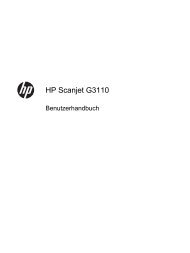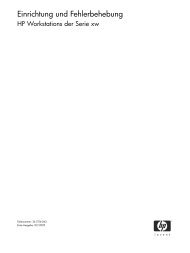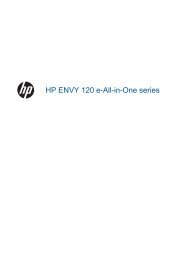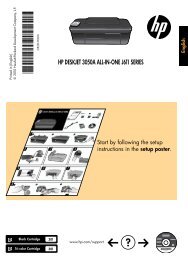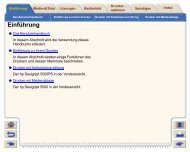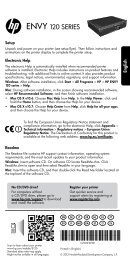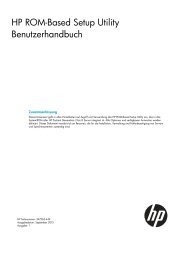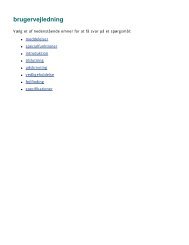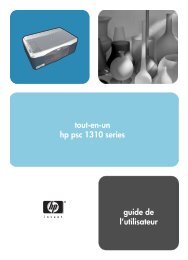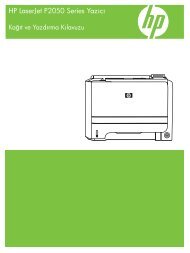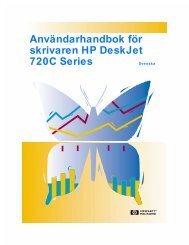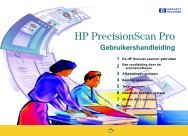HP LaserJet P2015 Printer Software Technical Reference - ENWW
HP LaserJet P2015 Printer Software Technical Reference - ENWW
HP LaserJet P2015 Printer Software Technical Reference - ENWW
Create successful ePaper yourself
Turn your PDF publications into a flip-book with our unique Google optimized e-Paper software.
◦ Rough paper. This setting increases transfer current. The texture in the surface of rough<br />
papers, such as cotton bond papers, carries a large portion of the surface area away from<br />
contact with the OPC drum. In this case, more transfer current is required.<br />
◦ Less/More transfer (-2, -1, +1, +2). These settings provide two levels of decreased transfer<br />
bias voltage and two levels of increased transfer bias voltage if the other adjustments are<br />
insufficient. Increment this control to find the best setting. In extreme case (very dry or very<br />
wet), low transfer current defects and high transfer current defects can overlap; that is, a<br />
defect-free setting might be impossible. These adjustments can help find the best operating<br />
point.<br />
● Duplex Transfer. Paper that has passed through the fuser before being printed on the second<br />
side is much drier and has higher resistivity than when the first side is printed. Therefore, the engine<br />
uses different transfer bias settings for the second side. It is common for the second side to show<br />
a transfer defect while the first side does not. These adjustments allow second-side defects to be<br />
improved without affecting transfer performance on the first side (or vice versa).<br />
The following settings are available for the Duplex Transfer control.<br />
◦ Dry paper. This setting increases transfer bias. Some papers (notably Chinese papers)<br />
become highly resistive in dry environments. To improve transfer, increase the transfer bias<br />
voltage. The range of paper resistivity in low humidity is so wide that a single, standard engine<br />
print mode cannot cover all the cases.<br />
◦ Humid paper. This setting decreases transfer bias. All papers absorb water at higher<br />
humidities and become electrically less resistive, resulting in transfer defects. The engine has<br />
a humidity sensor and also checks the conductivity of the ETB in order to estimate the humidity<br />
of the media, but this can be inadequate in more extreme cases.<br />
◦ Rough paper. This setting increases transfer current. The texture on the surface of rough<br />
papers, such as cotton bond papers, carries a large portion of the surface area away from<br />
contact with the OPC drum. In this case, more transfer current is required.<br />
◦ Less/More transfer (-2, -1, +1, +2) . These settings provide two levels of decreased transfer<br />
bias voltage and two levels of increased transfer bias voltage if the other adjustments are<br />
insufficient. Increment this control to find the best setting. In extreme case (very dry or very<br />
wet), low transfer current defects and high transfer current defects can overlap; that is, a<br />
defect-free setting might be impossible. These adjustments can help find the best operating<br />
point.<br />
● Toner. This adjustment is applied by the formatter.<br />
The following settings are available for the Toner control.<br />
◦ Less toner (-1, -2, -3) . These settings decrease the maximum primary toner amount from<br />
100% to 95%, 90%, and 85%, respectively. This is useful for fixing toner scatter on highresisitivity<br />
papers in low humidity environments.<br />
● Discharge. The following settings are available for the Discharge control.<br />
◦ On/Off. The <strong>HP</strong> <strong>LaserJet</strong> <strong>P2015</strong> printer has an electrostatic discharge brush where the paper<br />
separates from the ETB (before the fuser). This prevents toner scatter after a sudden paper<br />
discharge. Because the brush can sometimes make scatter worse, this setting is provided to<br />
turn the discharge brush off.<br />
48 Chapter 2 <strong>Software</strong> description <strong>ENWW</strong>



